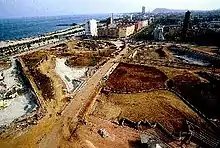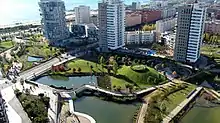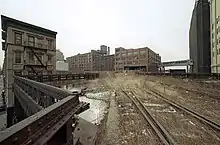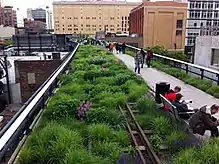Environmental gentrification
Environmental, ecological or green gentrification is a process in which cleaning up pollution or providing green amenities increases local property values and attracts wealthier residents to a previously polluted or disenfranchised neighbourhood.[1][2] Green amenities include green spaces, parks green roofs, gardens and green and energy efficient building materials. These initiatives can heal many environmental ills from industrialization and beautify urban landscapes. Additionally, greening is imperative for reaching a sustainable future. However, if accompanied by gentrification, such initiatives can have an ambiguous social impact if the poor (especially renters) are displaced or forced to pay higher housing costs.[2] First coined by Sieg et al. (2004),[3] environmental gentrification is a relatively new concept, although it can be considered as a new hybrid of the older and wider topics of gentrification and environmental justice. Various studies have analyzed the social implications of greening projects specifically with regards to housing affordability and displacement of vulnerable citizens.
Gentrification
Gentrification is a process whereby a neighbourhoods is transformed in order to cater to a wealthier home buyer or investor.[4] The process often takes place in working-class neighbourhoods that are inhabited by low-income residents. Real-estate development such as luxury condominiums or the transformation of old factories into trendy lofts, attract wealthier investors.[5][6] As the process progresses, low-income residents are pushed out or to the outskirts of the neighbourhood as real-estate and rent prices are increased due to demand. Also, as middle-class residents enter the neighbourhood surrounding businesses transform to accommodate desires. Gentrification has often been promoted by local governments through policies that promote ‘'urban renewal.'[4] Generally, the process is considered to benefit the local economy and improve neighbourhoods. Three phases of gentrification are generally recognized:
- 1960's-1970s - an irregular process led by the government which hoped to reinvest capital to the inner-city.
- 1970s - widespread in big cities and spreading to smaller towns across North America. Promotion of art communities such as Soho Manhattan to attract residents and investors.
- 1990s - extensive large-scale development increased in scale and complexity through public-private partnerships.[4][7]
As wealthier citizens have started to demand green amenities, cities have shifted their focus to marrying urban redevelopment with green initiatives all of which follow a similar process.
Urban planning and sustainability
Cities and individuals are responding the ecological crisis through eco-friendly planning and actions. Currently, the United Nations estimates that approximately 54% of the world's inhabitants are living in cities. This number is expected to increase to 66% by the year 2050.[8] In many ways, the city functions like a metabolic organism, extracting, using and disposing of resources across space and time. Therefore, studying the urban environment can often reveal spatial positions of power.[9] For example, in the United States there is a negative correlation between the provision of urban green space and African-American and Hispanic populations.[10] Spaces that are provided tend to have a lack in municipal upkeep and policing.[11] Additionally, green space in affluent neighbourhoods tend to promote activities for wealthy citizens which help to maintain a certain social order.[12]
Sustainability is a tool that has been used by governments and developers to promote green initiatives in cities.[13] Growing out of the promotion of sustainable development for developing countries, sustainability emerged as a global proposal at the 1992 United Nations Earth Summit. In theory, sustainability is achievable through a balance of three pillars - economy, environment and social equity.[14] However, in practice it still remains a challenge.[15] The social equity portion of sustainability is concerned with providing local communities ability to participate in decision-making as well as benefit from development projects.[15] Public participation aims to ensure that local concerns and needs are met.
In many examples, the redevelopment of brownsites (post-industrial areas) have become foundations for large-scale urban greening redevelopment. These sites are typical of past industrial landscapes - near the downtown core and waterfront and in need of environmental remediation. [16] Environmental redevelopments often promote sustainability through urban planning mechanisms such as new urbanism which promotes that planning that focus on building cities that are livable and walkable.[17][13]
Examples
Barcelona

Sant Marti District

A 15-year study (1990-2005) examined the social impacts or enhancing urban green spaces across the city of Barcelona. During the 1990s and 2000s, 18 new urban green parks were added to the city planning agenda.[18] First and foremost, as Barcelona was awarded the 1992 Olympic Games, the city prepared for the event through numerous urban developments which influenced a transformation of public spaces.[19] Previously, the city had been concerned with providing urban parks for the purpose of socializing and exercising. However, as the Olympics were swiftly approaching, urban planners and city governments took the opportunity to develop green spaces for mega-events.[20] These new types of spaces prioritize the aesthetic features of urban green space in an effort to attract tourists and offer memorable landscapes.[21] The legacy of mega-event urban parks can be observed in three notable parks around the city - Parc del Port Olimpic, Parc del Poblenou and Parc de Diagnol Mar. All three of these parks have shifted neighborhood demographics towards greater affluence.[20]
The city of Barcelona released its plan for sustainability titled Barcelona Green Infrastructure and Biodiversity Plan 2020. This document does not contain plans for housing affordability or social impacts that are a result from large-scale development.[15] Diagonal Mar project provides an example of the green initiatives being coupled with large-scale urban redevelopment on a previous brownfield site. Historically, the area was an industry hub as it is located near the Mediterranean Sea. The Diagonal Mar project includes luxury condominiums, three hotels, three office buildings, a shopping mall nested within an urban green space. The project has been criticized for not considering local input into planning as lacking spaces for social interactions for citizens.[2][21]
Studies suggest that green gentrification has occurred in correspondence with park development in the Sant Marti district. Using neighbourhood measurements of wealth, the authors suggest that demographic shifts of the neighbourhood have taken place at an alarming rate 1990-2005. Moreover, areas surrounding parks have experienced clear indicators of these changes as there has been an increase in: residents with a bachelor's degree, residents from the global North, household income or home sale and an overall decrease in the population of residents 65 and older living alone.[20]
| Time Period of Data | Park Name (Year Built) | Bachelor's Degree | District Avg. | Over 65 Years of Age | District Average | Global North Immigrant | District Average | Family Income | District Average |
|---|---|---|---|---|---|---|---|---|---|
| (1991-2006) | Parc del Port Olimpic (1992) | 27.92% | 7.59% | -1.52% | 1.82% | 7.4% | 3.22% | 19.21% | 2.8% |
| (1991-2006) | Parc del Poblenou (1992) | 25.98% | 7.59% | -2.97% | 1.82% | 6.9% | 3.22% | 14.42% | 2.8% |
| (2004-2006) | Parc de Diagnol Mar (2002) | 4.69% | 1.37% | -0.18% | 0.06% | 1.71% | 2.19% | 4.2% | 2.1% |
New York City

The High Line

The High Line, is a 1.45-mile-long (2.33 km) an elevated public park that was constructed on a historic freight line along the west side of Manhattan in New York City.[22] Previous to its redevelopment, the High Line represented the deterioration of New York’s industry, the neighbourhood of alongside the High Line, Chelsea, had frequent delinquency. Since the 1980s the city government has attempted to tear down this eyesore. In response, activists ventured to save this icon of history and instead promoted the idea that the High Line could be returned to the community as a provision of public good.[23] As the High Line was acquired by the CSX Transportation Inc. in 1999, community board meetings provided an avenue for alternative uses to be proposed.[24] At around the same time, Joshua David and Robert Hammond formed a non-profit they called Friends of the High Line of which their main goal was to acquire public and private funds to save the bridge from demolition. Notable celebrities - Edward Norton, Martha Stewart and Kevin Bacon provided financial support for the project.[25] Friends of the High Line presented a redevelopment strategy to the Bloomberg administration, promoting that the bridge could be converted into a public park. Friends Of the High Line suggested that this would provide economic benefits to the surrounding neighborhood and generate substantial tax revenues.[26] The Bloomberg administration accepted the initiative. Mayor Bloomberg provided a statement of support by stating, “The Board’s ruling is a great win for all New Yorkers. It allows us to implement our plans to preserve this valuable historic resource, create a much needed public open space and strengthen our city’s economy."[27]
Evidence that this project has ignited gentrification can be observed through the soaring real estate prices as well as types of activities that are being attracted to the High Line and its surrounding areas. In just two years, there has been a production of $2 Billion real-estate construction which has contributed an additional $900 million in tax revenues.[26] Additionally, the relocation of Whitney Museum of American Art nearby sheds light on the popularity of the park.
The High Line, although presented as a public park, privileges certain users and activities.[24] Friends of the High Line allow for only certain types of vendors as well as provides private security guards. Visitors of the High Line can enjoy artisanal foods, micro-brewed beer and browse up-scaled art merchant booths. The promotion of economic growth and certain types of consumption coupled with surveillance results in the neoliberalization of this public spaces.[24] Which is to say, The High Line, although a famous icon for the city, may fall short of providing open spaces and benefits for all citizens to use and enjoy.[24] Instead it more closely resembles a place of spatial 'privileged'[28] where claims to public space are dominated by upper-class citizens.
Concurrently in 2007, the Bloomberg administration released the PlaNYC 2030: A Greater, Greener New York which aimed to combat climate change through expanding sustainability measured with 132 initiatives. One goal highlights the social pillar of sustainability by having a goal that every citizen in the city will have a green space within a 10-minute walking distance from their home.
False Creek
The traditional urban layout of Vancouver was reminiscent of a small-town. Grid-iron patterned streets were lined with single-family dwellings, businesses could be found along main streets and industry was concentrated along shorelines and inlets. The 1960s ushered in a shift towards higher densities through high rise residential buildings in the downtown core. In the 1980s, redevelopment of brownsites (former industrial areas) for condominium development in the False Creek region was a result of it being the site for Expo 1986.[29] Previously, this area was the heartland of industry and had begun to deteriorate as industry shifted.[29] After the Expo the site was acquired by Hong Kong billionaire Li Ka-Shing for $320 million and a numerous residential luxury developments followed suite.[30] These developments promoted a tone of sustainability that were supported through planning documents such as Livable Region Strategic Planning (1996). Urban planning strategies such as Smart Growth stressed environmental goals could be achieved through the provision of walkable and mixed-use urban areas which would reduce urban sprawl.[31] Critiques of Smart Growth highlight the often ignored equity aspects of the strategy as they often ignore low-income residents.[32] Housing affordability became an issue during 2001-2007 as the price for a typical two-bedroom in the west end of Vancouver shifted from $260,000 to $650,000.[33] In 2008, the city council accepted EcoDensity as a solution to housing affordability which promoted further densification of downtown and surrounding neighbourhoods. EcoDensity is the solution to housing affordability rather than provision of social housing. A number of towers were constructed in the downtown Eastside displaced approximately 4,000 low-income residents from June 2007-January 2008.[33] Critiques of EcoDensity, suggest that the strategy does not account for enough citizen input in planning measures.[34]
Vancouver has become one of the most popular cities in the world to live as it offers breathtaking mountain views and access to numerous beaches. As Vancouver was awarded the 2010 Winter Olympics, which led to the development of “Millenium Water” along the South Eastern portion of False Creek which became the site for the Olympic Athlete Village. This project boasted European-styled walkways, green roofs and sustainability characteristics.[35] No low-income housing was provided with this project and one-bedroom condos starting price was $500,000.[35] In an effort to reduce ecological impacts, the project promoted a habitat restoration project whereby leftover dirt was used to create an island for bird nesting.[13] In 2006, water squatters, people living in boats in False Creek waters, were evicted in an effort to clean up the area.[13] The False Creek redevelopment was advertised as a park-like nature for new residents and tourists and promoted as a space for leisure.[36] Scholars suggest that there is a disconnect between the promotion of environmental discourses and issues of equity which results in a class conflict over space in the city.[33][13] Although Vancouver is a highly desirable place to live, the promotion of sustainability through policies ignores provision of much needed affordable housing allocations.
References
- Banzhaf, H. Spencer; McCormick, Eleanor (2006). "Moving beyond cleanup: Identifying the crucibles of environmental gentrification". NCEE Working Paper Series.
- Dooling, Sarah (2009). "Ecological gentrification: A research agenda exploring justice in the city". International Journal of Urban and Regional Research: 621–639.
- Sieg, Holger; Smith, V. Kerry; Banzhaf, H. Spencer; Walsh, Randall (2004). "Estimating the general equilibrium benefits of large changes in spatially delineated public goods". International Economic Review. 45 (4): 1047–77. CiteSeerX 10.1.1.462.768. doi:10.1111/j.0020-6598.2004.00297.x.
- Lees, Loretta; Slater, Tom; Wyly, Evlin K. (2008). Gentrification. New York: Routledge/Taylor & Francis Group.
- Ruth Glass (1964). London: aspects of change. London: MacGibbon & Kee.
- Zukin, Sharon (1989). Loft Living. Rutgers UP.
- Hackworth, Jason; Smith, Neil (2001). "The changing state of gentrification". Tijdschrift voor Economische en Sociale.
- Nations, United (2014). "World urbanization prospects: the 2014 revision, highlights". Population Division United Nations.
- Heynen, Nik; Kaika, Maria; Swyngedouw, Eric. "Urban political ecology". Urban Political Ecology and the Politics of Urban Metabolism.
- Wen, Ming (2013). "Spatial disparities in the distribution of parks and green spaces in the USA". Annals of Behavioral Medicine. 45 (Suppl 1): 18–27. doi:10.1007/s12160-012-9426-x. PMC 3590901. PMID 23334758.
- Brownlow, Alec (2006). "Inherited fragmentations and narratives of environmental control and entrepreneurial Philadelphia". In the Nature of Cities: Urban Political Ecology and the Politics of Urban Metabolism: 208–225.
- Dooling, Sarah (2008). "Ecological gentrification: re-negotiating justice in the city". Critical Planing. 15: 40–57.
- Quastel, Noah (2009). "Political ecologies of gentrifiction". Urban Geography. 7: 694–725.
- Adams, W. M. (2009). "The future of sustainability: re-thinking environment and development in the twenty-first century". Report for the IUCN Renowned Thinkings Meeting.
- Gould, Kenneth A.; Lewis, Tammy L. (2016). Green gentrification: urban sustainability and the struggle for environmental justice. Routledge.
- "Environmental Gentrification". Critical Sustainabilities. 2013-09-11. Retrieved 2020-10-15.
- Kuntsler, James Howard (1998). Home from nowhere: remaking our everyday world for the twenty-first century. A touchstone book.
- Parcs I, Jardins Barcelona (2007). "In Memoria". Barcelona: Ajuntament de Barcelona, Parcs I Jardins.
- Anguelovski, Isabelle (2014). "Community Reconstruction, Place Remaking, and Environmental Justice in the City". Neighborhood as a refuge: community reconstruction, place remaking, and environmental justice in the city. MIT Press. ISBN 9780262525695. JSTOR j.ctt9qf73z.
- Anguelovski, Isabelle (2017). "Assessing green gentrification in historically disenfranchised neighborhoods: a longitudinal and spatial analysis of Barcelona". Urban Geography: 1–34.
- Sauri, David (2009). "Changing conceptions of sustainability in Barcelona's public parks". Geographical Review. 99 (1): 23–36. doi:10.1111/j.1931-0846.2009.tb00416.x.
- Green, F (September 21, 2014). "New High Line section opens, extending the park to 34th St". Daily News. Archived from the original on September 21, 2014. Retrieved February 23, 2018.
- David, Joshua; Hammond, Robert (2011). High Line: The inside story of New York city's park in the sky. FSG Originals.
- Loughran, Kevin (2014). "Parks for profit: The high line, growth machines, and uneven development of urban public spaces". City & Community. 13 (1): 49–68. doi:10.1111/cico.12050.
- Demonchaux, Thomas (May 8, 2005). "How everyone jumped aboard a railroad to nowhere". Retrieved February 23, 2018.
- McGeehan, Patrick (June 5, 2011). "The High Line isn't just a sight to see; it's also an economic dynamo". New York Times.
- Friends of the High Line. "Mayor authorization for High Line project [press release]".
- Kimmel, Michael (2003). PrivilegeL A Reader. Boulder, CO: Westview Press.
- Mills, Caroline A. (1988). ""Life on the upslope": the postmodern landscape of gentrification". Environment and Planning D: Society and Space. 6 (2): 169–190. doi:10.1068/d060169.
- Olda, K. (1998). "Globalization and urban change: tales from Vancouver via Hong Kong". Urban Geography. 19 (4): 360–385. doi:10.2747/0272-3638.19.4.360.
- Krueger, Rob (2005). "Sustainability schizophrenia or "actually existing sustainabilities? toward a broader understanding of politics and promises of local sustainability in the US". Geoforum: 410–417.
- Pozdena, Randal J. (2002). "Smart growth and its effects on housing markets: the new segregation". National Center for Public Policy Research.
- Lee, Marc (2008). "Affordable EcoDensity - Making affordable housing a core principle of Vancouver's EcoDensity charter". The Canadian Center for Policy Research.
- Robinson, Pamela (2009). New growth-management experiments in Canada. Planning for climate change: strategies for mitigation and adaptation for spatial planners.
- Millenium Water (2008). "Vancouver's last waterfront community". Retrieved February 20, 2018.
- Braun, Bruce (2002). The intemperate rainforest: nature, culture and power on Canada's west coast. U of Minnesota Press.